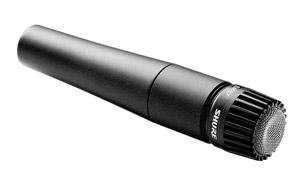MICROPHONES
North Suburban HAMMOND ORGAN Service
The next microphone type that we should look at is the dynamic mic. These are very common, and they can be very good also. A dynamic microphone works on the same principle as a typical generator in a power plant, that is, relative motion between an electrical conductor and a magnetic field induces a voltage in the conductor which will cause a current to flow, and this current varies with the motion.
In a typical dynamic microphone, there is both a powerful permanent magnet and also a tiny coil of fine wire. As in all microphones, a flexible diaphragm responds to soundwaves and vibrates, thereby also vibrating the attached small coil of wire. The mechanical vibration of the coil of wire induces an AC audio voltage in the coil. When the mic is connected to the input of an amplifier, a tiny current flows in this circuit which the amplifier increases enough to drive speakers, or perhaps recording equipment. There is a sub-class of dynamic microphones known as ribbon microphones.

Figure 6. A Shure brand dynamic microphone of excellent quality, suitable for exacting musical work.
In a ribbon microphone, there is a very light, thin corrugated ribbon, usually of aluminum. The ribbon is placed in the magnetic field and any vibration of the ribbon generates the appropriate audio voltage. Here are pictures of both a typical modern dynamic microphone and also a ribbon microphone.
The frequency response of both of these types is excellent, both in terms of range, and also it is much less irregular than that of either crystal or carbon microphones. These microphones can be used for serious, good quality recording of musical instruments. We'll look at this more when we look at the various response characteristic graphs of different microphone types.
The one (sometimes) disadvantage of a dynamic microphone is that the combination of a diaphragm with a coil attached has a little more weight and mass than other types which makes it slightly less responsive to high frequencies. The ribbon microphone's ribbon can be made really thin and light, but then this makes the microphone delicate to the point that some of them can be permanently damaged if used outdoors in a strong wind.
In either case, the dynamic microphone is in most typical representative examples, capable of a far better quality result than either carbon or crystal microphones, and dynamic mics are an important part of any good recording studio's equipment inventory.

Figure 7. A classic ribbon microphone, used for years in radio broadcasting studios.
Many consider the ribbon mic in a separate class, but inasmuch as it uses a moving conductor of electricity working in a magnetic field, we could put it in the general classification of dynamic microphones. Ribbon microphones have a figure eight pickup pattern. The name is derived from the shape of the microphone response graph. These mics respond very well to signals coming in from either the front or the back, but poorly to signals coming from either side. This makes them ideal in certain situations, such as an interview with two people sitting on opposite sides of a table or desk. They could also find practical usage in many music recording situations with instruments on opposite sides of a central area, a prime example would be a pipe organ which is divided on either side of a church chancel.
Page 4. Previous page | Next page